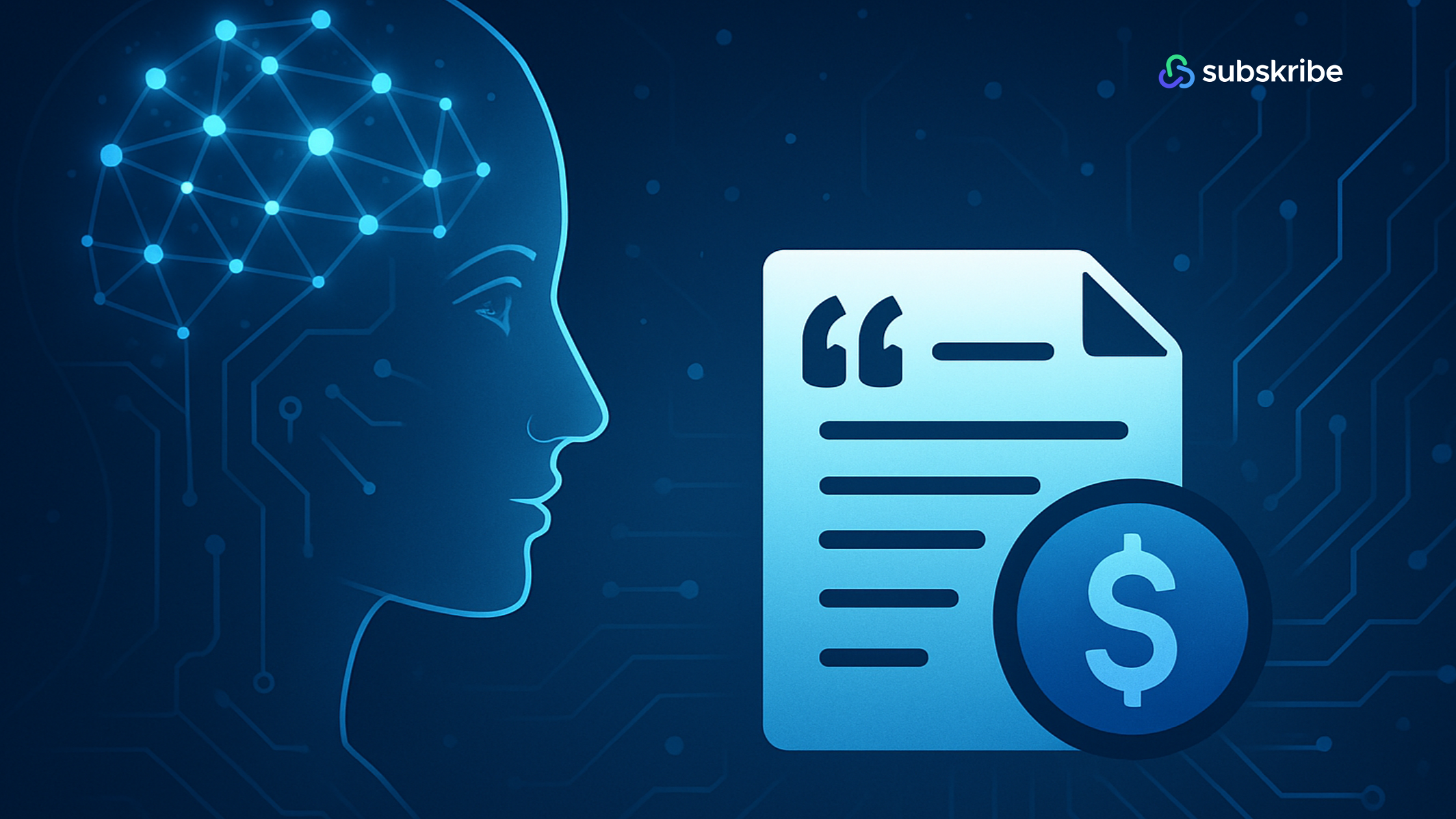The AI revolution has fundamentally changed how software companies create and deliver value. While traditional SaaS businesses could rely on predictable seat-based or tier-based pricing models, AI companies face a dramatically different reality. Your costs fluctuate with model inference calls, your value delivery varies by usage intensity, and your customers expect transparent, usage-based pricing that aligns with their actual AI utilization.
Yet most AI companies are still trying to force-fit their innovative products into outdated billing frameworks designed for simpler software models. This mismatch creates significant challenges, not just in quoting accuracy and billing precision, but also in forecasting revenue. Traditional pricing strategies simply don't offer the flexibility or visibility needed to predict revenue in a world where usage can vary wildly from one customer to another. And when quoting, billing, and forecasting break down, it directly impacts your bottom line and customer satisfaction.
The Billing Challenges of AI Companies
Billing is not just a back-office function for AI companies, it’s a strategic lever that directly impacts customer experience, revenue growth, and operational scalability. But most AI companies today are navigating uncharted territory when it comes to quoting and billing. Unlike traditional SaaS businesses that sell by seat or fixed plans, AI companies deliver value in far more dynamic and variable ways: through API calls, data processed, compute time, or even task complexity.
This variability presents a unique challenge: How do you define and price “value” when value itself changes by the minute, the model, or the use case?
Let’s say your AI platform offers natural language processing. One customer may use it to tag metadata for 5,000 articles per month. Another may run complex summarization models on millions of legal documents. Both use the same platform, but the resource consumption, cost to serve, and business value delivered are radically different. A one-size-fits-all pricing model can’t possibly accommodate these nuances.
As a result, AI companies often face the following challenges:
- Quoting complexity: Sales teams struggle to generate accurate quotes because usage isn’t fixed or predictable. Should they quote based on estimated token usage? Number of documents? Types of models used? Each option affects margins differently.
- Revenue unpredictability: Traditional SaaS pricing (like per-seat or flat monthly fees) makes revenue forecasting relatively straightforward. But with AI services, where usage can spike based on business cycles or customer experimentation, revenue can be volatile and hard to predict.
- Misaligned incentives: If pricing doesn't reflect how customers gain value, adoption slows down. Undercharging for high-compute use cases erodes margins; overcharging for light usage drives churn. Striking the right balance is crucial.
- Operational bottlenecks: Without flexible and modern CPQ and billing systems, pricing innovation turns into a manual, error-prone process. Finance teams spend hours reconciling bills, while product and revenue teams lack the data they need to optimize pricing strategies.
- Customer trust issues: When customers receive invoices they can’t understand based on token counts, compute hours, or ambiguous model usage, they lose trust. Billing becomes a support burden and a reason for churn.
The Cost of Staying with an Outdated Billing Framework
Using outdated and traditional quoting and billing systems is not only inconvenient but it also actively damages your growth and profitability. Here are the real problems AI companies face when they stick with inadequate quoting and billing infrastructure:
- Sales Team Paralysis: Your sales team can't close deals when they can't accurately quote prospects. Without proper cost modeling, they either quote too high (losing deals) or too low (destroying margins).
- Revenue Leakage and Margin Erosion Without accurate usage tracking, you're likely undercharging customers for high-compute features while overcharging for simple tasks.
- Customer Churn from Billing Disputes: Customers don't trust what they can't understand. AI companies find that the customer service tickets relate to billing confusion, leading to delayed payments and customer frustration, which eventually switch to competitors with transparent pricing.
- Poor Revenue Intelligence: The analytics do not identify your most profitable customer segments or optimize your product offerings around high-value use cases. This blind spot prevents you from maximizing revenue opportunities.
How This Impacts Every Team
The ripple effects of inadequate billing systems extend far beyond your finance department, creating operational bottlenecks across your entire organization:
Sales Teams: Can't provide accurate quotes for complex AI usage scenarios, leading to longer sales cycles and lost deals
Customer Success Teams: Unable to identify upselling opportunities or proactively manage accounts without clear usage visibility
Product Team: Lack data on feature adoption, friction, and profitability to guide product roadmap decisions
Finance Team: Spend excessive time on manual billing reconciliation instead of strategic revenue analysis
RevOps Team: Cannot optimize pricing strategies or forecast accurately without granular usage data
Leadership: Uninformed decisions due to poor visibility into unit economics and customer profitability
Modern Quoting and Billing for AI Services
For AI companies, quoting and billing isn’t just a transactional layer. It’s where product design, customer value, and revenue model intersect. Unlike generic SaaS companies, AI businesses must constantly experiment with pricing models that reflect the fast-changing nature of AI adoption and infrastructure costs.
That’s why forward-looking AI companies need to rethink their pricing strategies entirely, not just to bill more accurately, but to align pricing with value, unlock new segments, and grow predictably.
So, how are they doing it?
Let’s take a look at some real-world examples of how leading AI companies structure their pricing models and what we can learn from each.
Examples of Different Pricing Strategies of AI Companies
1. Usage‑Based Billing (Postpaid API / pay‑as‑you‑go)
In usage-based billing, also called pay-as-you-go. You are charged based on how much of the product you actually use. No upfront commitment, no bundles, no tiers. Just pure consumption.
Let’s break it down using OpenAI’s API pricing for its models.
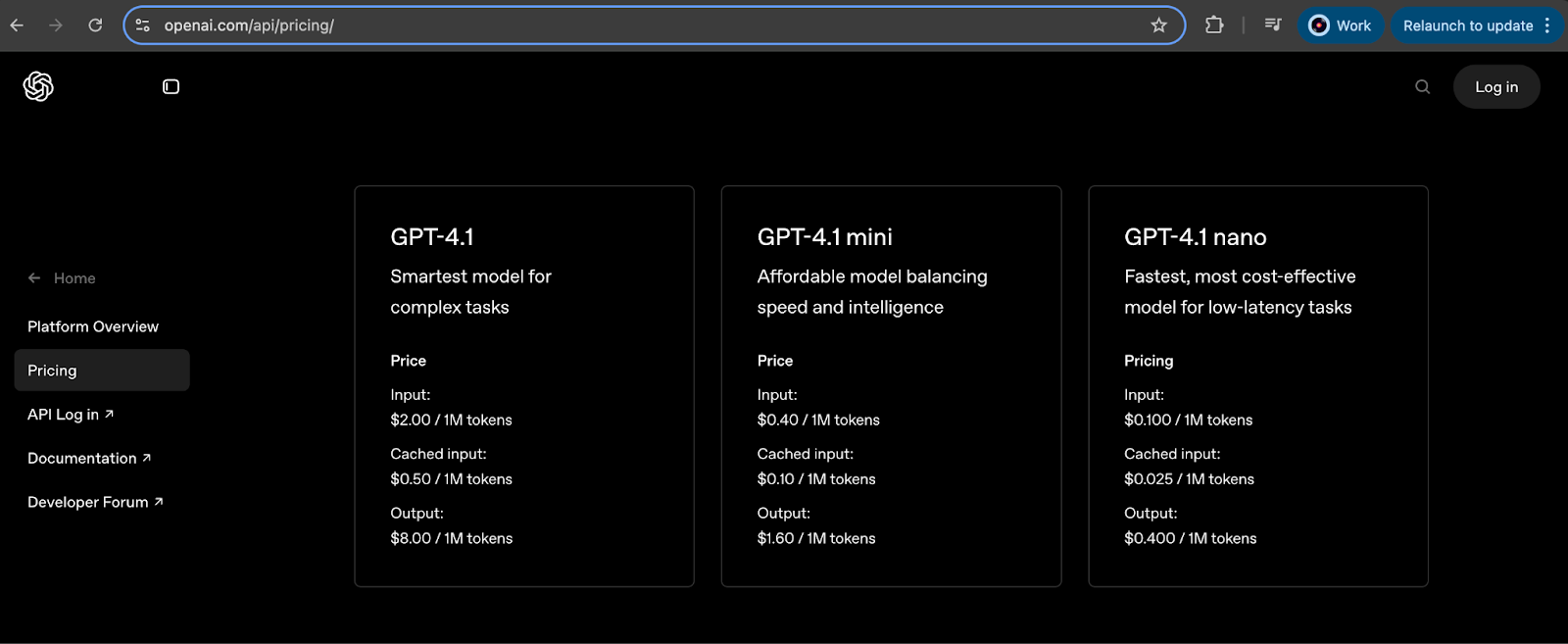
Source URL: https://openai.com/api/pricing/
How the Usage-Based Model works:
- You don’t choose a plan or commit to a fixed cost.
- You’re charged at the end of the billing period based on total tokens used.
- You can use any model anytime. There’s no lock-in or user/license count.
- Pricing is fully metered and transparent.
2. Prepaid Usage Buckets / Credit-Based Pricing
AI companies often need to strike a balance between monetizing advanced capabilities and giving users the flexibility to explore. That’s where credit-based or prepaid usage models come in. In this approach, customers purchase a bundle of usage credits upfront, which they can consume as they use the product.
Let’s take a look at Notion’s pricing model as an example.
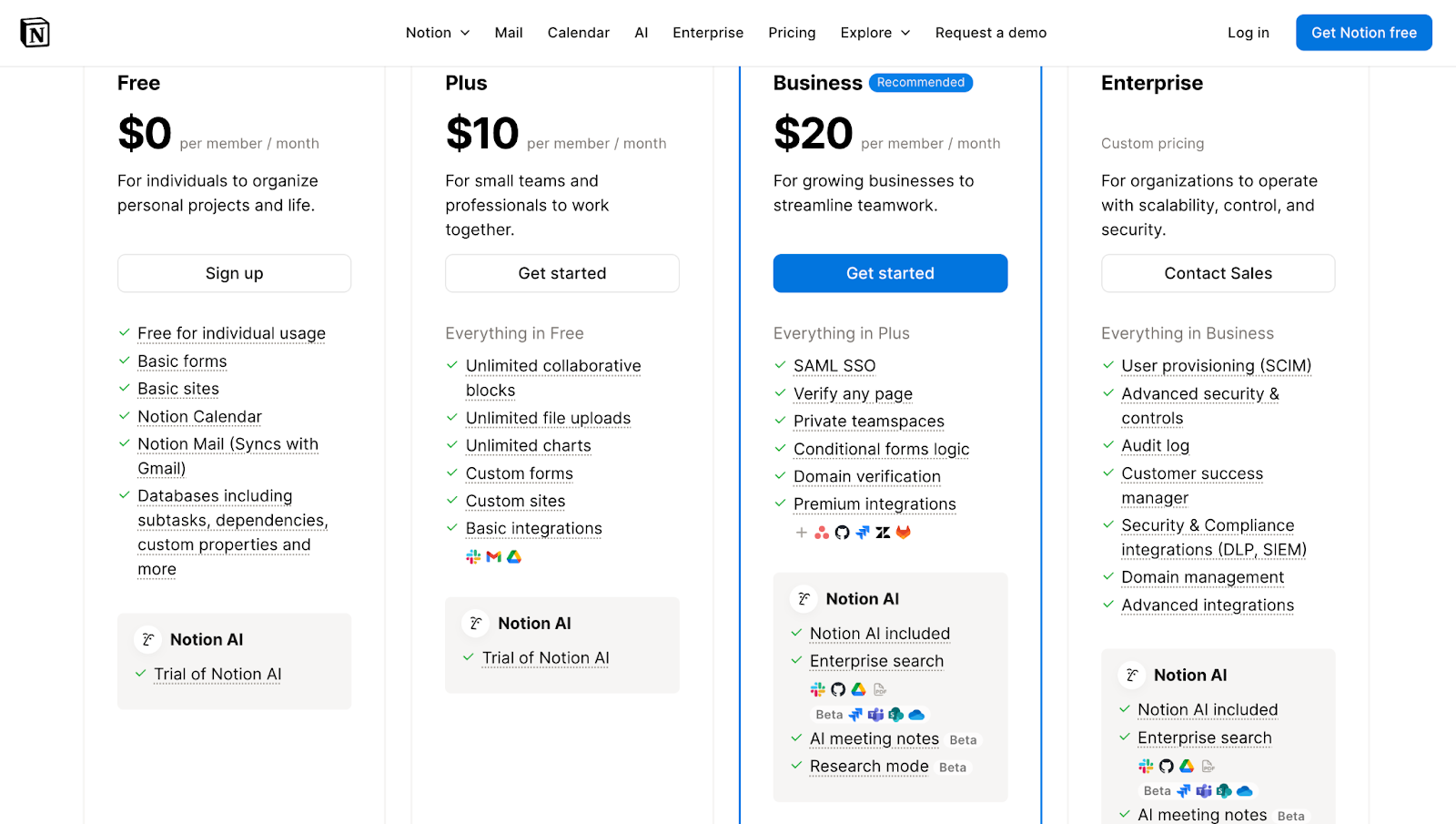
Source URL: https://www.notion.com/pricing
How the credit-based pricing works:
- Customers subscribe to a workspace plan (seat-based).
- Separately, they get access to Notion AI features like research, meeting notes, etc.
- These AI features draw from a prepaid pool of credits (either included in the plan or purchased separately).
- Once credits run out, the AI usage stops unless they buy more.
3. Seat-Based Pricing with Usage Limits
Airtable’s pricing strategy is built around charging per user (seat), while offering usage limits that scale with the plan tier. This is a common model for collaboration and productivity platforms that serve both small teams and enterprise users.
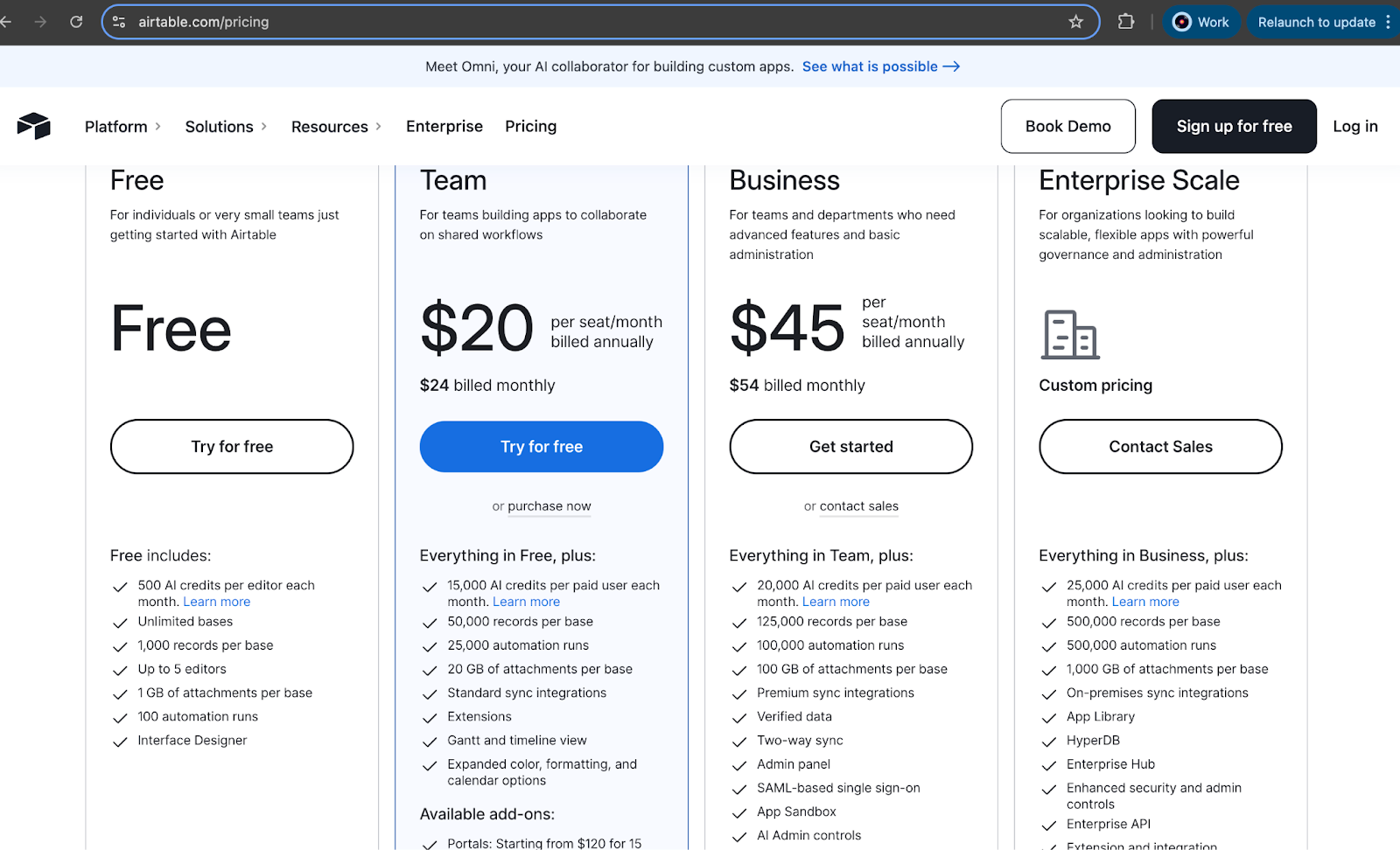
Source URL: https://airtable.com/pricing
How Seat-based pricing works:
- You pay per user. E.g., $20/seat/month or $45/seat/month (billed annually)
- Each seat gets access to fixed monthly usage limits, such as:
- AI credits per user (e.g., 15K, 20K, 25K/month)
- Records per base
- Automation runs
- Attachment storage
- Higher plans unlock more generous limits, along with advanced features (admin controls, SSO, sandbox, etc.).
3. Tiered Pricing
Synthesia’s pricing is a classic example of a tiered model, where customers can pick from distinct plans based on features, usage limits, and team size.
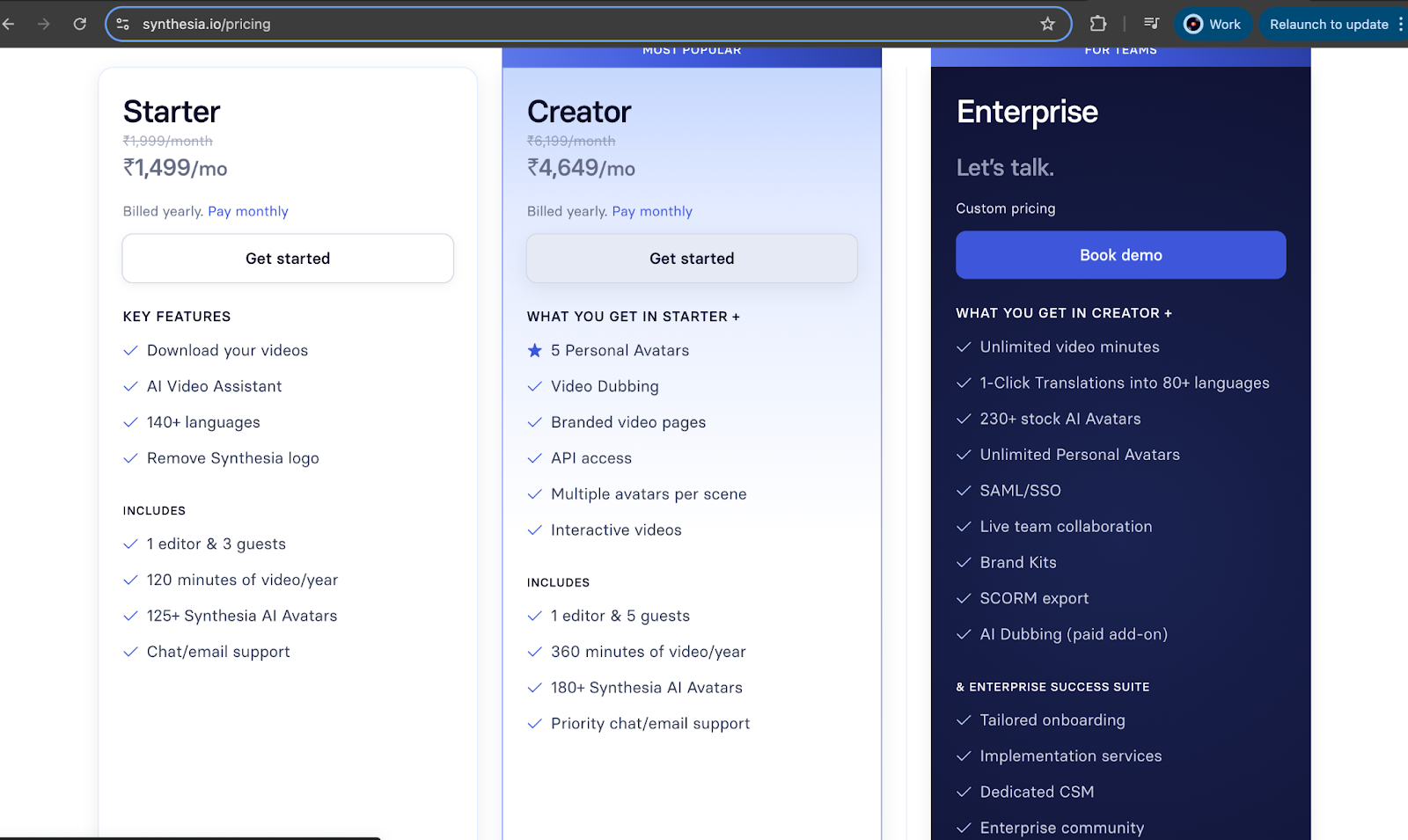
Source URL: https://www.synthesia.io/pricing
How Tiered pricing works:
- You pick a plan (tier) based on your team’s needs and the volume of AI-generated videos you expect to produce.
- Each plan includes fixed yearly usage limits and access to features.
- Higher tiers unlock more output capacity and advanced AI capabilities, plus dedicated support and security features like onboarding, etc.
4. Feature-Based Pricing
AI capabilities often introduce distinct, high-value features that customers may or may not need depending on their use case. Instead of bundling these features into core plans, many SaaS companies opt for Feature-Based or Add-On Pricing, where customers can selectively pay for premium AI functionality layered on top of their base subscription.
Here is an example of how Loom does it.
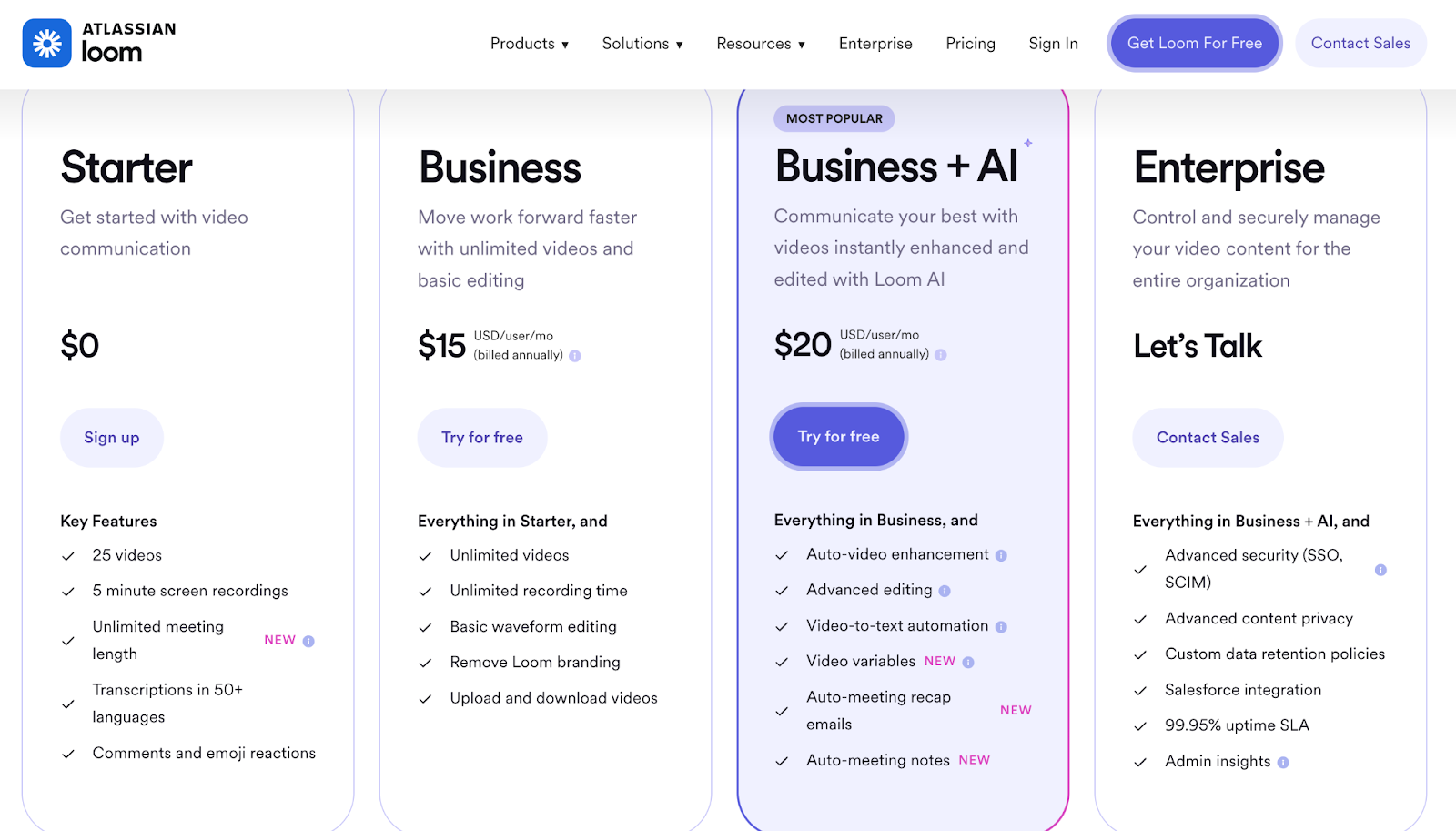
Source URL: https://www.loom.com/pricing
How Feature-based pricing works:
Customers choose a base plan (e.g., Business, Pro, Starter) and can optionally add premium AI features for an additional cost. This creates flexibility by letting teams access core capabilities at a lower price, while power users or advanced teams can unlock AI features if needed.
5. Hybrid Pricing Models and Contract-Based Pricing Models:
Some pricing pages feature a Hybrid Pricing Model, where multiple pricing strategies, such as tiered, seat-based, and feature-based, are bundled together to address diverse customer needs. Slack and Loom are great examples of this blended approach.
On the other hand, Custom or Contract-Based Pricing is often used for enterprise customers with complex requirements. These plans don’t display fixed rates but prompt users to “Contact Sales”, signaling tailored pricing based on usage, scale, or support needs.
Conclusion
As AI companies continue to push the boundaries of innovation, their business models are evolving just as rapidly. But with that innovation comes operational complexity, especially when it comes to quoting and billing. Whether it’s per-call pricing, tiered usage, or bundled services, the need for a flexible and scalable billing infrastructure is no longer optional; it’s mission-critical.
The takeaway is clear: AI companies need more than just a billing system. They need a platform that understands the nuances of AI monetization, supports real-time changes, and eliminates the friction between teams. Because when quoting and billing are done right, they stop being roadblocks and start becoming accelerators for growth.
Transform Your AI Billing with Subskribe
While traditional billing systems struggle with the dynamic nature of AI services, Subskribe has been built specifically to handle the sophisticated needs of AI companies' quoting and pricing strategies. Notable AI companies like Cresta, Vivun, and Beamery trust Subskribe to power their usage-based billing and implement complex pricing models that scale with their AI innovation.
How Subskribe got you covered with Smart Quoting and Scalable Billing
- Intelligent CPQ (Configure, Price, Quote): Easily build and send accurate quotes, even for complex AI pricing models like per-seat + usage, tiered pricing, or feature-based upsells, all in a few clicks.
- Flexible Usage-Based Billing: Subskribe supports granular metering and billing based on real-time consumption, making it ideal for AI companies with variable usage patterns, model inference rates, or API call volumes
- Native Integration with RevRec: Subskibe ties quoting, billing, and revenue recognition into one flow, a critical aspect for AI companies with multi-element arrangements, such as bundled software, services, and consumption.
Ready to transform your AI-powered business’s CPQ and Billing from a growth bottleneck into a competitive advantage? Discover how Subskribe can address your quoting and billing challenges and drive growth for your AI company.

